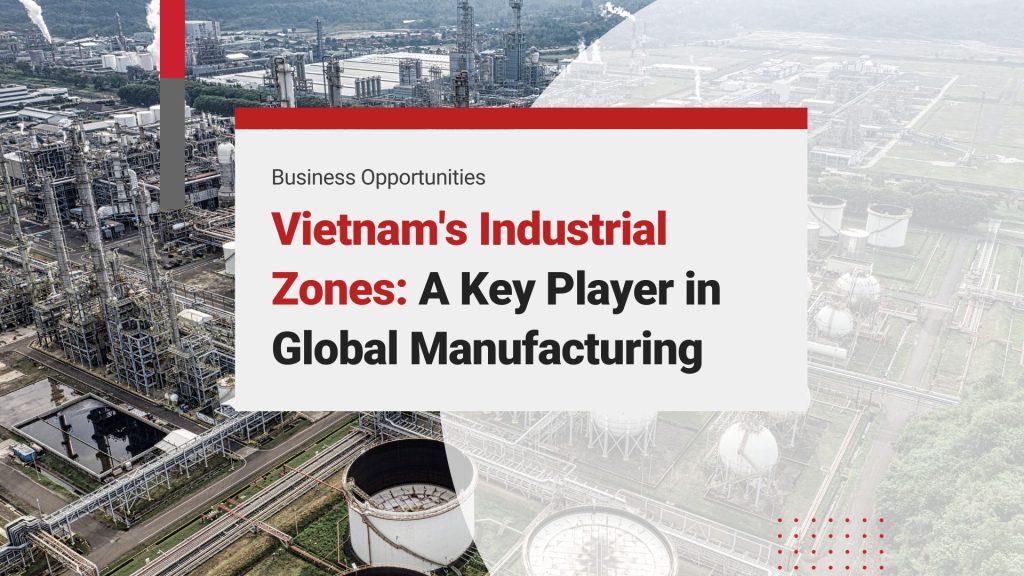For global manufacturing firms looking for diversity and to strengthen the resilience of their supply chains, Vietnam has emerged as a prominent target. Vietnam presents an exceptional opportunity for foreign investors due to its stable political system, dedication to sustainable growth, low inflation, high FDI inflows, young and technologically advanced population, and dynamic industrial zones.
Read More: Doing Business in Vietnam as a Foreigner: What, Where, Why, How?
According to the World Bank, Vietnam’s economic growth is expected to rebound to 6.5 percent in 2024 as domestic inflation could subside from 2024 onward. This will be further supported by the accelerating recovery of its main export markets (U.S., Eurozone, and China). The strong 8% economic growth in Vietnam last year is predicted to slow to 6.3% in 2023 as rising costs and interest rates burden investors and people.
Investing in Vietnam? Check Out InCorp’s Incorporation Services in Vietnam

Northern Industrial Hubs
Hanoi
Hanoi is the capital of Vietnam and is situated in northern Vietnam on the western bank of the Red River, about 85 miles (140 km) inland from the South China Sea. The City has a population density considerably higher in the urban area, approaching 20,100 per square kilometer.
Hanoi has been developing several critical industries selectively during 2021-2015, focusing on the sectors and products using cutting-edge technologies and having high added value. The development of high-tech businesses with significant export potentials, such as digital control, automation, robotics, nano, plasma, laser, and biotechnology, is gradually changing the City’s industrial sector.
Other manufacturing sectors, such as motor vehicles, shipbuilding, food processing, steel, petrochemicals, and software, have been identified as crucial.
Hanoi has been developing industrial parks for the 2021-2025 period. Hanoi has 70 operational industrial clusters and grasslands in 17 districts and towns, covering 1,868 hectares and contributing significantly to economic development and social welfare.
One of the most well-known industrial parks is Hoa Lac Hi-tech Park, which services businesses in the commerce and software development industries. It is the first and largest hi-tech park in Vietnam, with a total area of 1586 hectares in Hanoi’s Capital. The park consists of the following main function industrial zones:
- Software development zone
- Training and research zone
- High-tech industrial zone
- Residential zone
- Service zone
Haiphong
Hai Phong is one of the largest and most important seaports in Northern Vietnam. It is also one of the most modern seaports in Southeast Asia, with advanced navigation and networking facilities. Hai Phong Port handles large cargo and passengers and is an essential gateway for Vietnam’s trade with other countries. The port is located on the coast of the Gulf of Tonkin, which is one of the busiest shipping lanes in the world.
The industry is critical in Haiphong, including food processing, light, and heavy industries. Some major industries in Haiphong are shipbuilding, textiles, cement, paper, steel, and chemicals. Haiphong has traded goods with more than 40 countries and territories worldwide. Haiphong is also home to many factories and industrial parks. It is striving to become one of the largest commercial centers in the country.
Hai Phong has 12 industrial parks, including eight industrial zones in the Dinh Vu – Cat Hai economic zone and four outside industrial parks.
Most of the large industrial parks in Hai Phong are in three districts: Hai An, An Duong, and Thuy Nguyen. These districts share the same borders and have good access to the airport, the seaports, and main roads like National Highway 5A.
Central Industrial Hubs
Da Nang
Da Nang is located in the South Central Coast geography zone of Vietnam. The terrain of Da Nang includes mainlands and islands. Da Nang is the largest city in central Vietnam and one of the country’s most important ports. The mountains surround the City to the west and the South China Sea to the east.
Da Nang’s key industries include machinery, electronics, chemicals, and shipbuilding. Shipbuilding is an attractive industry, with the South China Sea tensions boosting demand for naval and coast guard ships.
Da Nang City has six concentrated industrial parks, including Hoa Khanh, Da Nang, Lien Chieu, expanded Hoa Khanh, Hoa Cam, and Da Nang Fisheries Services, with a scale of 1,066.52 ha. Lien Chieu Industrial Park is one of them, located in Lien Chieu district, Da Nang city. The park has an area of 1,200 hectares and is expected to attract investment in electronics, mechanics, and high-tech industries.
Quang Nam – Da Nang economic zone
The Quang Nam- Da Nang economic zone is one of the key industrial zones in Central Vietnam. It comprises Thua Thien Hue, Da Nang, Quang Nam, Quang Ngai and Binh Dinh provinces. This region plays a significant role in the socio-economic development strategy and ensures the security and defense of the Central Coast and Central Highlands.
The primary industries in the Quang Nam: Da Nang economic zone are food processing, textiles, building materials, and paper and forest products. However, oil and gas, shipbuilding, logistics, and other high-tech industries will increase in the next few years.
Several industrial parks are in the Quang Nam – Da Nang economic zone. Some of the prominent ones include:
- Dien Nam – Dien Ngoc Industrial Park: Located in the Dien Ban district, Quang Nam province’s Dien Nam and Dien Ngoc communes. The park has a 418-acre surface area.
- Hoa Cam Industrial Park: Located in Hoa Thuan Dong ward, Hai Chau district, Da Nang City. The park covers an area of 200 hectares.
- Lien Chieu Industrial Park: Located in Hoa Thuan Dong ward, Hai Chau district, Da Nang City. It is owned by the Da Nang Investment and Development Fund. The park covers an area of 1,200 hectares.
Southern Industrial Hubs
Ho Chi Minh City
Ho Chi Minh is the largest city in Vietnam. The City is located on the Saigon River and is Vietnam’s principal port and largest City, with an estimated population of over eight million. The City covers about 2,061 km2.
Ho Chi Minh City is home to several key industries and sectors. Some of the prominent ones include:
- Textile and garment industry: The city is one of the largest textile and garment manufacturing centers in Vietnam
- Electronics industry: The city has a growing electronics industry with several multinational companies having their manufacturing plants in the city
- Food processing industry: The city has a well-developed food processing industry with several large companies having their manufacturing plants in the city
- Chemical industry: The city has a well-developed chemical industry with several large companies having their manufacturing plants in the city.
Some of the notable industrial parks in Ho Chi Minh City include:
- Hiep Phuoc Industrial Park: Located in Nha Be District, Ho Chi Minh City. With a total area of 1,686 hectares, Hiep Phuoc is the largest industrial park in the city
- Saigon Hi-Tech Park: Located 15 km from downtown Ho Chi Minh City, opposite Thu Duc University Village. The park covers an area of 326 ha (95% utilized) and is currently being expanded to 913 ha.
- Tan Tao Industrial Park: Located in Binh Tan District, Ho Chi Minh City. The park covers an area of 400 hectares and is home to over 200 companies.
Dong Nai
Southeast Vietnam’s Dong Nai province may be near Ho Chi Minh City. It is part of Vietnam’s southern critical economic region and has attracted investments in electronic component manufacturing, textile and garment production, and tech-intensive industrial goods manufacturing.
Dong Nai has attracted investments in the production of textiles and apparel: electronic component manufacturing and technologically complex industrial items.
Some of the major industrial parks in Dong Nai include:
- Amata Industrial Park: Located in Bien Hoa City, Dong Nai Province. The park covers an area of 700 hectares and is home to over 200 companies
- Long Duc Industrial Park: Located in Long Thanh District, Dong Nai Province. The park covers an area of 400 hectares and is home to over 100 companies
- Song May Industrial Park: Located in Trang Bom District, Dong Nai Province. The park covers an area of 300 hectares and is home to over 100 companies
Binh Duong
Binh Duong is a province in the Southeastern part of Vietnam with high economic growth and dynamic industrial development. Binh Duong is considered the gateway to HCMC, the economic and cultural center of the country. Geographically located in the center of the ASEAN region, Binh Duong defines the core of Vietnam’s Southern Key Economic Zone.
Binh Duong has a diverse economy with a focus on manufacturing and services. The province is home to many industrial parks and export processing industrial zones. Key industries include textiles, garments, footwear, electronics, food processing, and furniture.
Binh Duong is home to many industrial parks and companies. Some notable industrial parks in Binh Duong are Phong Phu Industrial Park and Binh Duong Industrial Park.
In addition, the Vietnam Singapore Industrial Park (VSIP) has three locations in Binh Duong Province: Thuan An Town, Bac Tan Uyen District, and Ben Cat District.
Can Tho
Can Tho is the largest city in the Mekong Delta, located on the western bank of the Hau River, and is the economic and cultural center of the region. It is also the gateway to the floating markets, the biggest tourist attraction in the area.
Can Tho is known for its agricultural products such as rice, fruit, and fish. The City is also home to many industrial parks and factories that produce textiles, garments, footwear, and other consumer goods.
Several industrial parks in Can Tho are prominent. One of them is the Tra Noc 1 and 2 industrial parks. These parks have been transformed into eco-industrial park models, saving 19,000 tons of oil, 30,000 tons of coal, 600,000 m3 of water, and 130,000 tons of CO2.
We made the most detailed step-by-step guide for Company Incorporation in Vietnam for investors, now available as an interactive checklist:

Why do Vietnam’s Industrial Hubs become attractive to foreign manufacturers?
Vietnam Emerges as Top Destination for Foreign Manufacturing Companies
In recent years, Vietnam has emerged as a top destination for foreign manufacturing companies seeking to diversify and increase the resiliency of their supply chains. With a stable political system, commitment to sustainable growth, relatively low inflation, strong FDI inflows, a youthful and digital population, and a robust manufacturing sector, Vietnam offers an extraordinary opportunity for international investors.
Strategic Location and Advantages in Shipping
Vietnam has emerged as a desirable destination because of its strategic position and advantages in shipping as international corporations look to reduce their dependence on China and take advantage of regional growth potential. The nation has access to important maritime lanes including the East-West Economic Corridor, which connects Myanmar with Thailand via Laos and Vietnam. It is situated in the center of Southeast Asia. Additionally, it is close to important consumer markets including China, Japan, South Korea, India, and ASEAN.
Competitive Labor Costs
One of the key advantages that make Vietnam an attractive destination for foreign manufacturing companies is its competitive labor costs. Compared to other countries in the region like China or Thailand where labor costs are rising fast due to economic development or demographic shifts leading towards aging populations; Vietnamese workers are known for their hard-working ethic while still maintaining reasonable rates.
Efficient Taxation Policies Dedicated Solely Towards Manufacturing Sector
Vietnam’s attractiveness as a manufacturing hub is further boosted by efficient taxation policies dedicated solely towards the manufacturing sector. Investors can benefit from massive tax reductions depending on their project size which ultimately strengthens the competitiveness of Vietnam’s manufacturing industry compared to its regional peers.
Free Trade Agreements (FTAs)
The Vietnamese government has been proactively enticing businesses with free trade agreements (FTAs) which provide better accessibility for foreign businesses while allowing Vietnam to reduce tariffs with partner countries. This ultimately strengthens the competitiveness of Vietnam’s manufacturing industry compared to its regional peers.
Textile and Garment Industry
The textile and garment industry plays an increasingly important role in the economic growth of Vietnam, making it the fourth-largest garment exporter globally after China and the EU. In 2021 alone, export value was estimated at US$29 billion up by 13.2 percent over 2020 with projections indicating that this trend will continue into 2022 where they expect exports ranging from US$39 billion dollars up to US$42 billion.
High-Tech Industries
Despite strong development in recent years within other sectors such as footwear production or apparel manufacturing electronics lags behind significantly when compared globally yet this is something that Vietnamese authorities are keen on changing by attracting high-tech industries through incentives and FDI support policies.
Conclusion
In conclusion, Vietnam’s manufacturing industry has witnessed an increase in foreign investment due to its strategic location, competitive labor costs, efficient taxation policies, trade agreements with partner countries as well as an increasingly supportive government keen on attracting high-tech industries through incentives and FDI support policies. The prospects for Vietnam’s manufacturing sector look promising in upcoming years as more investors consider expansion strategies into prolific economies such as Vietnam which are technologically prepared and digitally driven to offer a good mix of incentives for production sectors seeking stability.
About Us
InCorp Vietnam is a leading provider of global market entry services. We are part of InCorp group, a regional leader in corporate solutions, that encompasses 8 countries in Asia-Pacific, headquartered in Singapore. With over 1,100 legal experts serving over 15,000 Corporate Clients across the region, our expertise speaks for itself. We provide transparent legal consulting, setup, and advice based on local requirements to make your business perfectly fit into the market with healthy growth.
Don’t take our word for it. Read some .
Verified by
Ian Comandao
Business Consulting Manager at InCorp Vietnam
Ian is a sales and marketing professional who has worked over 15 years in key accounts management.






